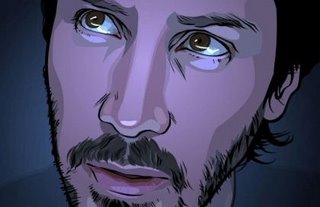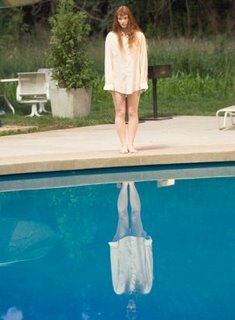 From crashing the wedding to crashing the honeymoon, Owen Wilson continues his one-man assault on the funny bones of the world with this middling ménage-a-trois comedy, which might be underwritten and derivative but still provides a fine platform for the golden boy’s easy charms.
From crashing the wedding to crashing the honeymoon, Owen Wilson continues his one-man assault on the funny bones of the world with this middling ménage-a-trois comedy, which might be underwritten and derivative but still provides a fine platform for the golden boy’s easy charms.Three is a Crowd
 From crashing the wedding to crashing the honeymoon, Owen Wilson continues his one-man assault on the funny bones of the world with this middling ménage-a-trois comedy, which might be underwritten and derivative but still provides a fine platform for the golden boy’s easy charms.
From crashing the wedding to crashing the honeymoon, Owen Wilson continues his one-man assault on the funny bones of the world with this middling ménage-a-trois comedy, which might be underwritten and derivative but still provides a fine platform for the golden boy’s easy charms.What Does A Scanner See?
 Richard Linklater is for me, one of those hit or miss filmmakers but regardless (- I have to stop myself going into my anti Before Sunrise, Before Sunset rant here. Give me a minute-...) one with the ability and determination to make his own personal, experimental films, like them or not (-deep breath-) while at the same time crafting slick commercial entertainments like School of Rock. Thankfully A Scanner Darkly is a hit, but a perverse one. A meditation on the nature of addiction and perceptions of reality presented as a paranoid, psychedelic freak-out, Scanner Darkly is real, surreal and hyper-real and all at the same time. It’s as close as science-fiction cinema has come since Blade Runner to capturing the vibrancy, intensity and complexity of Phillip K Dick’s fiction. That it achieves this while being made more linear and accessible and frequently very funny, marks it out from the crowd of others that have tried and failed to translate Dick’s warped, wild visions into ‘must-see’ cinema.
Richard Linklater is for me, one of those hit or miss filmmakers but regardless (- I have to stop myself going into my anti Before Sunrise, Before Sunset rant here. Give me a minute-...) one with the ability and determination to make his own personal, experimental films, like them or not (-deep breath-) while at the same time crafting slick commercial entertainments like School of Rock. Thankfully A Scanner Darkly is a hit, but a perverse one. A meditation on the nature of addiction and perceptions of reality presented as a paranoid, psychedelic freak-out, Scanner Darkly is real, surreal and hyper-real and all at the same time. It’s as close as science-fiction cinema has come since Blade Runner to capturing the vibrancy, intensity and complexity of Phillip K Dick’s fiction. That it achieves this while being made more linear and accessible and frequently very funny, marks it out from the crowd of others that have tried and failed to translate Dick’s warped, wild visions into ‘must-see’ cinema. "A Lightning Doodle Project"

Long exposure times and coloured torches allow the Japanese animators at PIKAPIKA to eat light and shit magic.
Not Waving But Drowning
 Lucky old Harry Farber (Bob Balaban), the newspaper film critic in M Night Shyamalan’s bizarre and incompetent new film about a beautiful sea nymph called Story (Bryce Dallas Howard) who inspires ordinary people to do magical things. The socially awkward, snippy new arrival to The Cove, an apartment building managed by Cleveland Heep (Paul Giamatti), encounters a CGI monster three-quarters of the way through The Lady In The Water, and is so spared the sight of talents like Paul Giamatti, Jeffrey Wright and Bryce Dallas Howard struggle through to an uncaring finish, not waving but drowning.
Lucky old Harry Farber (Bob Balaban), the newspaper film critic in M Night Shyamalan’s bizarre and incompetent new film about a beautiful sea nymph called Story (Bryce Dallas Howard) who inspires ordinary people to do magical things. The socially awkward, snippy new arrival to The Cove, an apartment building managed by Cleveland Heep (Paul Giamatti), encounters a CGI monster three-quarters of the way through The Lady In The Water, and is so spared the sight of talents like Paul Giamatti, Jeffrey Wright and Bryce Dallas Howard struggle through to an uncaring finish, not waving but drowning.
Engine Trouble

Lightning McQueen (Owen Wilson) is a confident, charming young racing car, in his rookie year on the competitive circuit and desperate to make his name. Having lost his companion Mack The Truck (returning Pixar favourite John Ratzenberger), Lightning is speeding along the famous old Route 66 when he crashes, literally, into sleepy Radiator Springs, destroying the main street and causing consternation among the few inhabitant automobiles that remain in the almost-abandoned roadside town. Brought before the judge, Doc Hudson (Paul Newman), the cocky racer is sentenced to community service, which must be completed before he can leave to get to the final race of the season. Lightning must win the coveted Piston Cup in order to secure a better contract with a more glamorous, better equipped sponsor, introducing an element of beat-the-clock to his court-appointed good works, his efforts to restore the town dwindling spirits, assemble a new pit crew and win the heart (carburettor?) of the smart, optimistic local beauty, Sally The Porsche, brightly voiced by Bonnie Hunt. The rest of the folks in town, a population that offers various diversions and entertaining dead-ends, include the slow-witted Mater The Tow Truck (voiced by a US hillbilly comedian called Larry the Cable Guy), Fillmore The VW Van (George Carlin) a free-wheeling throwback specialising in ‘natural’ fuels, and Tony Shalhoub and Guido Quaroni as the Ferrari-loving tyre specialists Luigi and Guido.
The films two big racing set-pieces top and tail the central story, leaving long sections of the film without much in the way of excitement, visual or otherwise. Ultimately, the story here is too twee and culturally specific to connect with audiences with the same impact as the undersea spaces of Nemo or the alternate universes of Toy Story. Cars laps at a much slower pace than Pixar usually set, extending the middle section of the film at the cost of making scant introductions and one-track characterisations that in turn reduce any surprises when it comes to the chequered flag. It’s also the least funny of the studio’s films, or perhaps my ignorance of the scenarios of NASCAR racing meant most of it went over my head. The score, from regular Pixar tunesmith Randy Newman, is virtually anonymous, not helped by the absence of the space in which to stage a jaunty sing-along. Squealing tyres and revving engines fill in instead, at volume.






